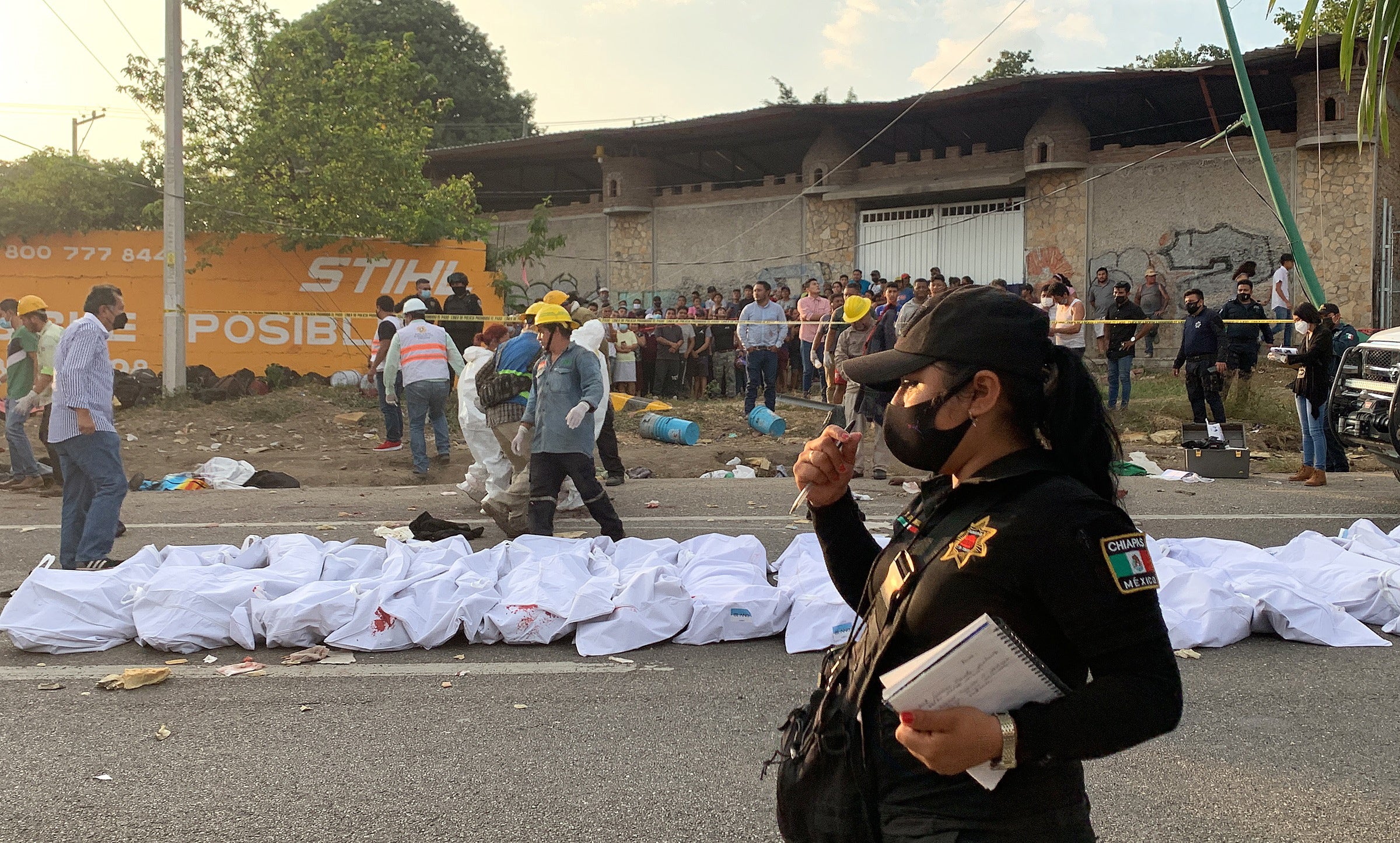The migrant trail that lead to Mexico truck tragedy and more than 50 people dead
Land route from Central America to the US is among the world’s deadliest, yet some 2 million people have attempted it since 2017, reports Chris Havler-Barrett in Mexico City

Despite hard-line initiatives by the United States and Mexican governments, 2021 has seen a record number of migrants attempt to cross from Central American and Caribbean nations to gain entry to the south of the US.
While the final leg of this route – from the sprawl of Mexico City to the border regions of Coahuila, Chihuahua and Tamaulipas – form the most infamous sections of the journey, with mass executions, trafficking and crime commonplace occurrences, the earlier stages of the route are no less dangerous.
The death of at least 54 migrants in Chiapas is a stark reminder that this heavily trafficked route is fraught with peril from the outset.
The majority of the dead in Thursday’s accident were reportedly from Guatemala, Honduras and El Salvador, part of the infamous “Northern Triangle”, where serious violence and economic inequality drive migrants to look for work in the United States.
The Northern Triangle, which also includes Honduras, is marked by ineffective and corrupt governance, and the prevalence of organised gangs – such as the notorious MS-13 – who dominate and control every aspect of daily life.
The region was decimated by a series of brutal civil conflicts in the Eighties and Nineties, from which it has never properly recovered. Figures released by the Migration Policy Institute suggest that as many as 50 per cent of people in the region live in poverty.
With GDP in Honduras and El Salvador contracting 9 per cent and 10 per cent respectively in 2020, there are few resources available to those who choose to remain at home.
Climate change has also severely damaged the Northern Triangle region, with increased hurricane activity in the last two years killing livestock and ruining crops on a devastating scale. The UN World Food Programme estimates that 17.3 million people living in the region are currently facing moderate to severe food scarcity.
With little alternative available, those looking for safety and financial security are often driven to attempt the almost 2,000-mile journey north, to the United States.
With the further social and economic damage caused to the region by Covid-19 and renewed optimism that the Biden administration would allow increased numbers of Central Americans to enter the United States, more than 228,000 migrants have attempted the 2,000-mile journey in 2021 alone.
Those making the difficult passage north are also spurred on by rumours that anyone arriving in the United States will be given unrestricted entry and immediate citizenship, spread both by members of the Republican Party and traffickers themselves, say the Mexican government.
The remote state of Chiapas is a major milestone for travellers, where those seeking passage to the US will cross into Mexico for the first time.
Chiapas is struggling with a humanitarian crisis, with up to 50,000 Haitian migrants who unsuccessfully tried to cross the US border earlier this year trapped in the town of Tapachula on the Guatemalan border, with little support made available.
Significant numbers of daily travellers crossing into the region have overwhelmed authorities, who are unable to prevent determined, large-scale migrations with highly limited resources and rampant corruption within their ranks.
The isolated southern state is also the place in which many of the “caravans” – a long-time bogeyman of US politics – often begin to form, as groups band together for protection against cartels and traffickers that prey on migrants.
December has also seen the relaunch of the highly-controversial Trump-era “Remain in Mexico” policy – where those applying for asylum in the US are required to stay on the Mexican side of the border until their applications have been processed, which can take years.
A reality of Remain in Mexico is huge camps on the US border that have become breeding grounds for criminal activity.
Despite promises from the White House that the reintroduced measures would seek to “improve humanitarian components” and that the Biden administration has sought to implement “key changes”, there is anger that the scheme has been reintroduced, with opposition from Homeland Security chief Alejandro Mayorkas stating that the scheme “fails to provide the fair process and humanitarian protections that all persons deserve”.
Despite this, the policy is unlikely to deter those looking to escape violence in their countries of origin.

Critically, however, it is not just the United States that is now seeking to return migrants to their countries of origin. With immigration, a forming cornerstone of US-Mexico relations, Mexican authorities have also looked to detain and repatriate those they suspect of being illegal migrants.
This has simply driven the industry even further underground as desperate people now look to evade detection at every stage of their journey. More than 82,600 people were reportedly detained then deported in Mexico between January and October 2021, according to official statistics.
Earlier this week, Mexican authorities detained 143 people – all of whom were from Guatemala and Nicaragua – in Oaxaca. Like those killed on Thursday, they were discovered in cramped conditions in the back of a truck.
The Mexican National Commission on Human Rights (CNDH) estimates that between 2011 and 2020, more than 70,000 migrants went missing while trying to make the journey. The southern regions of Chiapas and Tabasco – where migrants will often change hands between criminal groups – are rated among the regions with the highest number of disappeared.
While the governments of the United States and Mexico continue to unveil tough new measures to combat migration, without meaningful efforts to improve living conditions in the Northern Triangle there is little deterrent for those seeking a better life in the United States.






Join our commenting forum
Join thought-provoking conversations, follow other Independent readers and see their replies
Comments